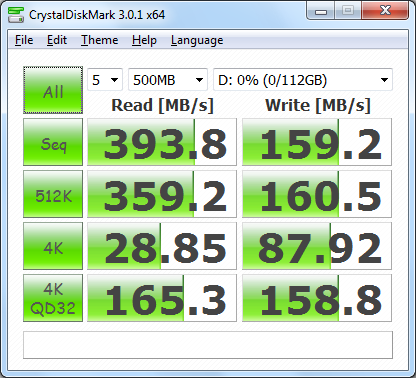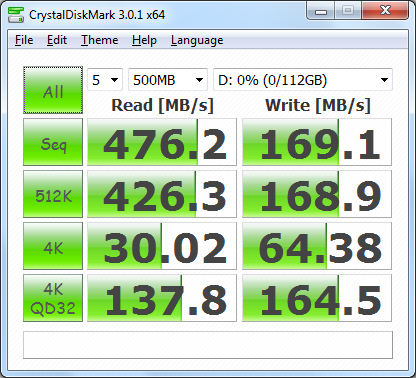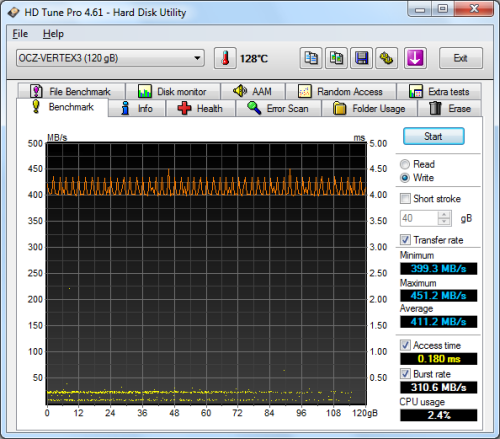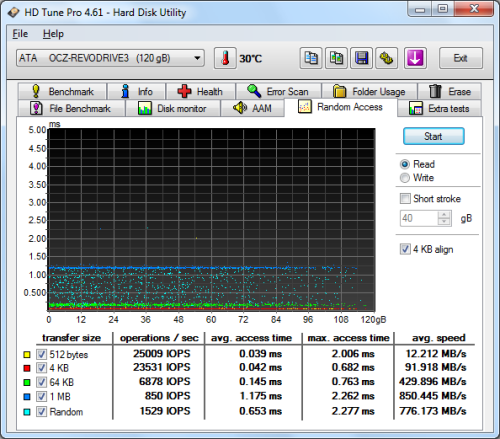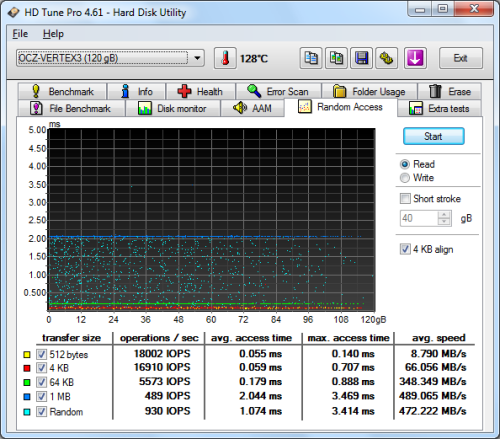

Model: OCZ RevoDrive 3 120GB PCIe Solid State Drive
Manufacturer: OCZ Technology
Provided By: OCZ Technology
OCZ Technology is no stranger to the computer industry. Founded by enthusiasts, for enthusiasts, the company entered the memory market in 2002. Determined to manufacture the very best memory for overclockers, OCZ quickly established itself as a leader in the industry by breaking speed barriers and maintaining a reputation of quality. Today, OCZ continues to innovate. Along with their line of enthusiast-oriented power supplies, the company offers a wide range of high-performance SSD solutions for the enterprise and consumer markets.
 With solid-state technology advancing at a faster rate than traditional interfaces, OCZ has begun to look for ways to eliminate the SATA bottleneck. Last summer the company launched its RevoDrive 3 series of PCIe-based SSDs. Designed with power users and multimedia designers in mind, this bootable, workstation-class SSD employs a PCIe 2.0 4x interface as well as two SandForce SF-2281 controllers in RAID 0 to deliver up to 1000MB/s read and 925MB/s write speeds as well as a maximum of 130,000 4KB random write IOPS.
With solid-state technology advancing at a faster rate than traditional interfaces, OCZ has begun to look for ways to eliminate the SATA bottleneck. Last summer the company launched its RevoDrive 3 series of PCIe-based SSDs. Designed with power users and multimedia designers in mind, this bootable, workstation-class SSD employs a PCIe 2.0 4x interface as well as two SandForce SF-2281 controllers in RAID 0 to deliver up to 1000MB/s read and 925MB/s write speeds as well as a maximum of 130,000 4KB random write IOPS.
Along with exceptional performance, the RevoDrive 3 features OCZ’s proprietary Virtualized Controller Architecture (VCA) 2.0. Included in this feature-set are OCZ’s exclusive command queuing and queue balancing algorithms, which are handled by the onboard processing core for higher performance and reduced burden on the host CPU. VCA 2.0 also offers SMART data monitoring and is the only virtualization layer in the industry with TRIM and SCSI unmap support to enhance sustained performance and provide greater endurance by reducing the overhead associated with garbage collection.
For this review, OCZ sent us the 120GB version of the RevoDrive 3. This SSD is capable of delivering up to 975 MB/s sequential read and 875 MB/s sequential write speeds as well as up to 120,000 random write IOPS.
| OCZ RevoDrive 3 120GB PCIe Solid State Drive | |||||||||||||||||||||||||||||||||||||
General Specifications
Performance
Reliability
Power Consumption
Environmental
Dimensions and Weight
Other Features
|
Needless to say, this is only a taste of what the RevoDrive 3 has to offer. To give you an idea of what to expect, we'll take a closer look at OCZ's PCIe-based SSD and then see how well it performs. Does the RevoDrive 3 have what it takes? Can it deliver the performance we've come to expect from OCZ? Keep reading as we find out.
OCZ's VCA 2.0 (Virtualized Controller Architecture) is the next step in the evolution of enterprise flash virtualization layers. This follow up to the original VCA presents as a complete storage subsystem, but with an improved and expanded feature-set allowing unprecedented flexibility and industry-leading performance and reliability. Along with TRIM, SCSI unmap and SMART monitoring suport, VCA 2.0 features user-selectable data recovery and non-stop modes for unprecedented data protection. Unlike other flash virtualization layers, it also offers complete power fail protection. In the event of unexpected system power loss, OCZ’s enterprise power fail protection completes all in-progress transactions, protecting the integrity of all active data.
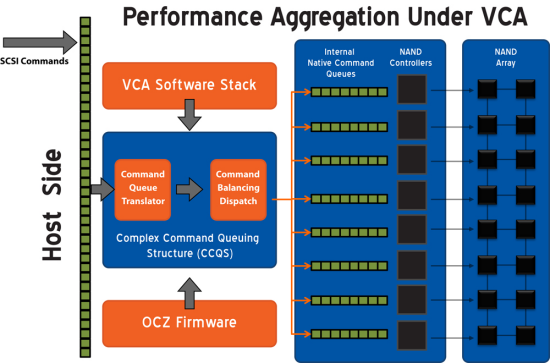
The OCZ SuperScale storage controller combines processing and full DMA (direct memory access) cores, as well as internal PCIe, SATA and SAS interfaces. This controller, combined with VCA 2.0 provides unique benefits to users by allowing certain DMA and data management functions including OCZ’s unique command queuing and queue balance algorithms to be handled by the onboard processing core, resulting in higher performance and reduced burden on the host CPU.
In the enterprise PCIe implementation of VCA 2.0, users have the option of treating each SuperScale accelerator as one more Virtual Logical Drive (LUNs). Storage management software such as file systems, volume managers, and applications are able to access a number of LUNs allowing unprecedented flexibility in storage, while maintaining the hardware assisted features of VCA 2.0 and enabling the host to boot from the PCIe device.
VCA provides highly efficient performance aggregation across physical LUNs via an intelligent complex command queuing structure that utilizes both native and tagged command queuing (NCQ, TCQ). This is a unique technology that enables command switching and balancing based on OCZ’s proprietary Queue Balancing Algorithm (QBA) algorithm; this balances drive loading while maximizing internal bandwidth for nearly linear performance aggregation. VCA 2.0 LUNs can be further aggregated through cascading with host-side striping dependant on the storage architects needs. VCA is able to address NAND flash in an innovative way through the use of a massively parallel array, eliminating bottlenecks by increasing both read and write speeds up to the theoretical interface limit while keeping access latencies to a minimum.
Additionally, VCA 2.0 supports the industry standard SCSI command set over our PCIe interface. Because SCSI is the command set of choice of enterprise storage architects, this feature makes installation of OCZ PCIe devices in enterprise applications seamless. VCA technology can interpret and execute both SCSI and ATA commands across any physical interface and utilize any available internal interface to facilitate communication across multiple elements of the overall drive architecture. Current OCZ hardware implementations support SCSI commands over PCIe (Z-Drive) and Serial (Talos). This storage virtualization currently allows SCSI commands to be sent through PCIe or SAS physical interfaces to an internal virtualized array of NAND devices.
The RevoDrive 3 comes packaged in an attractive gray, black and blue box. Along with a picture of the drive, the front advertises many of its key features including its PCI-Express 2.0 x4 interface, VCA 2.0 architecture, and SuperScale storage accelerator. The back of the box provides a bit more information regarding the RevoDrive 3's features and capabilities.
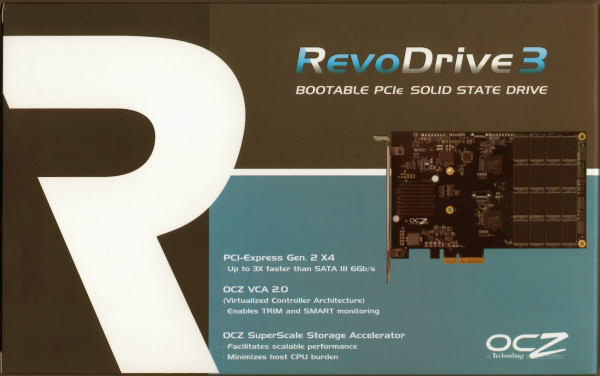

Inside the outer box is a second one made out of thick, glossy cardboard. To get at the box's contents, simply slide out the foam-filled tray. Along with the RevoDrive 3, you'll find a CD containing the driver and manual as well as a sticker that says "My SSD Is Faster Than Your HDD."

Physical Features:
Considering its capabilities, the RevoDrive 3 looks very unassuming. This full-height PCIe 2.0 x4 card is black in color and measures 167.64 x 98.42 x 15.25 mm. Unless you have a small form factor computer, you shouldn't have any problems fitting the drive in your case. The RevoDrive 3's SuperScale storage accelerator is covered entirely by a heatsink. However, the two SandForce SF-2281 processors are clearly visible in the picture below.
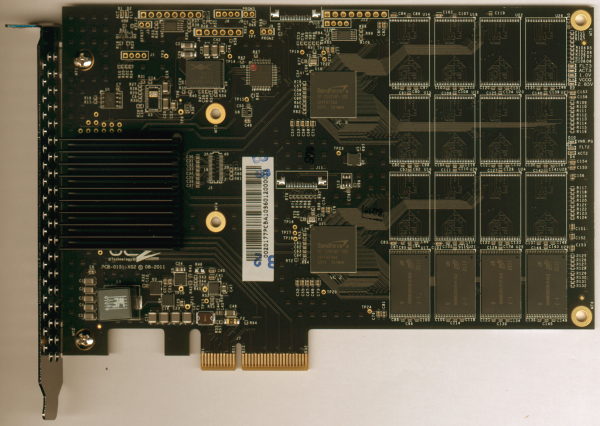

For the 120GB RevoDrive 3, OCZ opted to use Micron's 8GB 25nm 29F64G08CBAAA asynchronous NAND flash chips. Looking at the pictures above, you can see that there are four of these chips on the front of the PCB and twelve more on the back. If you do the math, you'll see that this equals 128GB and not the 120GB of storage the drive advertises. LSI's SandForce processor uses this extra 7% (8GB) to maximize read and write performance and extend the endurance and overall reliability of the drive.
The test system used in this review was an HP 8200 Elite. The computer came equipped with an Intel Core i5-2400 CPU, 4GB of DDR3 1333MHz memory, Seagate Barracuda 7200.12 ST3250312AS 250GB SATA 6 Gb/s hard drive, NVIDIA Quadro FX580 512MB PCIe graphics card and an Intel 82579-LM gigabit network card. For the operating system, I installed a fresh copy of Windows 7 Enterprise.
To test the performance of the OCZ RevoDrive 3, I ran a series of benchmarks using CrystalDiskMark 3.0.1, HD Tach RW 3.0.4.0, ATTO Disk Benchmark 2.46, AS SSD, HD Tune Pro 4.61 and Iometer. For comparison, I've also included test results from the SanDisk Extreme, Samsung 830 SSD, Plextor PX-256M3S, Patriot Pyro SE, Plextor PX-256M2P, Kingston HyperX, OCZ Vertex 3 and OCZ Agility 3.
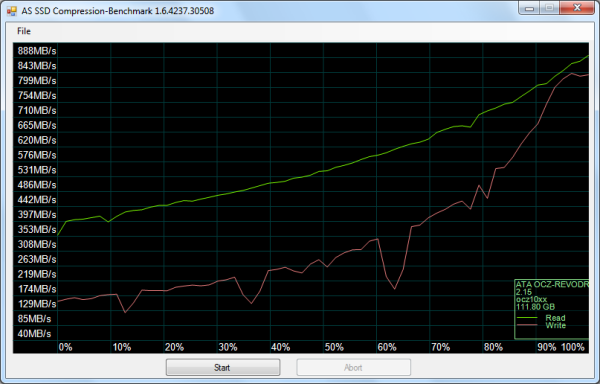
As I mentioned earlier, the RevoDrive 3 is based on LSI's SandForce SF-2281 controller. Like other SandForce controllers, the SF-2281 features a technology called DuraWrite, which uses data compression to lower write amplification and extend the life of the drive by reducing the number of program-erase cycles. This data compression also plays a big part in the controller's performance. The more the data can be compressed, the faster an SSD like the RevoDrive 3 is able to read and write. Looking at the screenshot above, you can see that there is a considerable performance difference when writing incompressible (0%) and compressible (100%) data.
CrystalDiskMark 3.0.1:
First, I ran a few quick tests using CrystalDiskMark. This benchmark tool measures the performance of a storage device by testing its sequential read and write speeds as well as its random read and write speeds using blocks 512K and 4K in size.
According to OCZ, the 120GB RevoDrive 3 is capable of reading at 975 MB/s and writing at 875 MB/s. The drive didn't come close to these numbers using CrystalDiskMark's default (random) test data. However, with the highly compressible 0x00 (0 Fill) data, the RevoDrive 3 was able to read at 821.4 MB/s and write at 730.7 MB/s.
HD Tach RW 3.0.4.0:
Next, I used HD Tach to test the RevoDrive 3's read, write and burst speeds as well as its seek times and CPU usage.

Looking at the screenshot above, you can see that the RevoDrive 3 had average read and write speeds of 417.9 MB/s and 364.0 MB/s respectively, as well as a burst speed of 637.6 MB/s.
ATTO Disk Benchmark 2.46:
I also used ATTO Disk Benchmark to test the RevoDrive 3's sequential read and write speeds. The tests are run using blocks ranging in size from 0.5KB to 8192KB and the total length set to 256MB.
When tested with ATTO, the RevoDrive 3's read speeds topped out at about 1020 MB/s and its write speeds at 872 MB/s.
AS SSD:
AS SSD is a relatively new benchmark designed specifically for solid state drives. The application contains five synthetic tests used to determine the sequential and random read and write performance of a drive. Take note that AS SSD uses incompressible data in its tests, which can have a major impact on the scores of SandForce-based drives like the RevoDrive 3.

AS SSD also includes a copy benchmark. This test copies an ISO (two large files), program (many small files) and game (small and large files), returning the speed and duration of each.
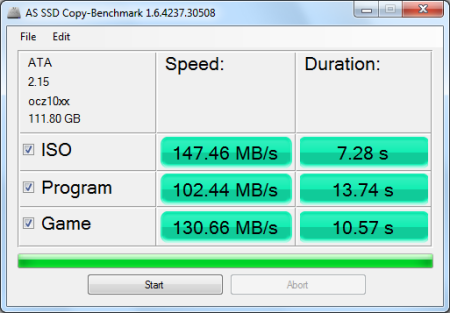
HD Tune Pro 4.61:
Next, I ran a series of tests using HD Tune Pro. This hard disk utility measures a drive's performance by testing its sequential read and write speeds as well as its access time, burst rate and CPU usage. For this review, I'm also going to use it to benchmark the RevoDrive 3's random read and write speeds, random access times and the number of operations per second.
The RevoDrive 3 performed very well when benchmarked with HD Tune. The drive had average read and write speeds of 844.4 MB/s and 718.2 MB/s, respectively, and a burst rate of 328.1 MB/s when reading.
 OCZ RevoDrive 3 120GB - HD Tune Random Access Write |
 OCZ Vertex 3 120GB - HD Tune Random Access Write |
The RevoDrive 3 didn't disappoint when doing random reads and writes. When writing 4KB blocks, the drive reached 21758 IOPS and had an average speed of 84.992 MB/s. The RevoDrive 3 was even faster when reading, reaching 23531 IOPS with an average speed of 91.918 MB/s.
Iometer:
Lastly, I ran a series of tests using Iometer. This tool can be configured to benchmark a number of things. In this case, I used it to measure the RevoDrive 3's read and write speeds and the number of operations per second. The tests were run using both repeating and random bytes and a queue depth of 3.

The RevoDrive 3's performance was very similar to what we saw in our other tests. With highly compressible, repeating data, the drive was able to read at 938.44 MB/s and write at 824.96 MB/s. When tested with random data, the RevoDrive 3's read and write speeds dropped to 359.74 MB/s and 154.89 MB/s, respectively.

The RevoDrive 3 performed quite well when doing random reads and writes. With repeating data, the drive was able to read at 50.9 MB/s and write at 296.59 MB/s. Here too, the RevoDrive 3 took a performance hit when tested with random data. However, it was still able to write at 146.07 MB/s.

According to OCZ, the RevoDrive 3 can deliver a maximum of 120,000 IOPS when randomly writing 4K blocks. In our tests, the drive reached 75,926 IOPS with repeating data and 37,395 IOPS with random data. This by itself is impressive. However, with the queue depth set to 32, the RevoDrive 3 reached an incredible 121,828 IOPS.
While SSDs offer many benefits, there are some downsides to using flash memory. One of the biggest issues people run into is performance degradation. Over time, an SSD will run out of fresh blocks and will have to write over data the file system has marked as deleted. This procedure is very complicated and can slow an SSD's write speeds considerably.
To address this problem, most manufacturers have added TRIM support to their SSDs. The TRIM command allows an operating system, such as Windows 7, to tell an SSD which data blocks are no longer in use. Using this information, the drive pro-actively erases these blocks and adds them to the free block pool.
While the RevoDrive 3 supports TRIM, this feature does not currently work with Windows 7. According to OCZ, Microsoft's Windows StorPort architecture does not support TRIM over SCSI, which is what their VCA 2.0 technology is based on. As a result, these commands are not generated by the OS so there is no way for VCA to execute them. SCSI unmap does not work with Windows 7 either which leaves us with the SandForce controller's built in garbage collection.
To test the RevoDrive 3's garbage collection function, I first put the drive in a "dirty" state. I used Iometer to fill the entire drive and then ran a random write test for 20 minutes. Looking at the screenshot below, you can see that the RevoDrive 3's average read and write speeds dropped to 113.7 MB/s and 187.5 MB/s, respectively.
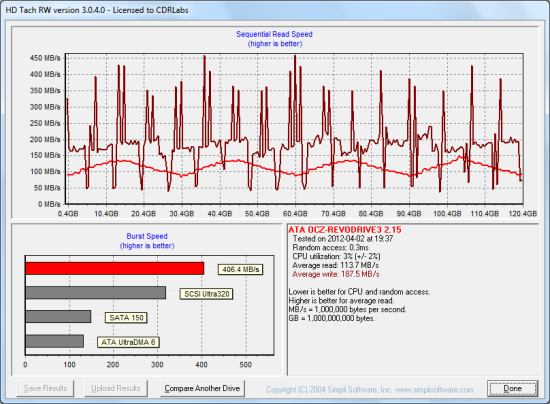
OCZ RevoDrive 3 - Dirty
To see how well the RevoDrive 3 could recover, I let the computer sit for a few hours and then reran the test. The drive's average write speed increased to 346.3 MB/s. However, its read speed lagged behind, averaging out at only 243.6 MB/s.
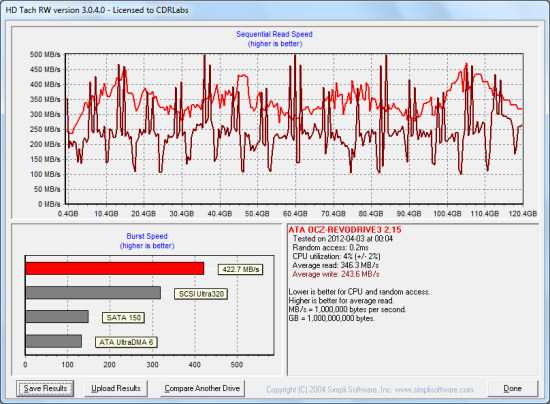
OCZ RevoDrive 3 - Garbage Collected
Lastly, I used OCZ's Toolbox utility to perform a secure erase on the RevoDrive 3. With the drive wiped clean, its read speed jumped back up to 402.8 MB/s.

OCZ RevoDrive 3 - After Secure Erase
Final Thoughts:
OCZ's RevoDrive 3 SSD is not for the average consumer or the enthusiast on a budget. However, for the power user who regularly pushes their PC to its limits, it may just be what the doctor ordered. The RevoDrive 3 combines a PCIe interface with not one, but two SandForce SF-2281controllers to deliver performance well beyond the realm of a single, SATA-based SSD. The RevoDrive 3 screamed through our sequential transfer rate tests, reading at speeds as high as 1020 MB/s and writing at more than 800 MB/s. It also took the top spot in our random write tests, producing more than 121,000 IOPS at high queue depths. Sadly, these numbers dropped considerably when reading and writing incompressible data. This is a common issue with SandForce-based drives but had an even bigger impact on the RevoDrive 3 due to its use of asynchronous NAND.
Aside from its steep price tag and use of asynchronous NAND, the only real issue I have with the RevoDrive 3 is its broken TRIM support. With a feature-set based on OCZ's VCA 2.0 technology, the drive is technically capable of supporting TRIM. However, due to limitations in Microsoft's StorPort architecture it does not currently work. OCZ is reportedly working with Microsoft to rectify this situation but, at this point, its unknown whether or not it will be fixed before the release of Windows 8 this fall.
The OCZ RevoDrive 3 is available now in 120GB, 240GB and 480GB capacities. The 120GB drive reviewed here currently retails for less than $364 with the 240GB and 480GB versions going for about $532 and $1360, respectively, on Amazon.
Highs:
- Available in 120GB, 240GB and 480GB capacities
- Excellent sequential read and write speeds
- Virtualized Controller Architecture (VCA) 2.0 offers enterprise-class features
- PCI-Express 2.0 x4 interface
- Bootable as a direct-attach device
- Supports TRIM, SCSI unmap and SMART monitoring
- 3 year warranty
Lows:
- TRIM and SCSI unmap are not currently supported by Windows 7
- Considerably slower with incompressible data
- Asynchronous NAND flash
- Pricey
